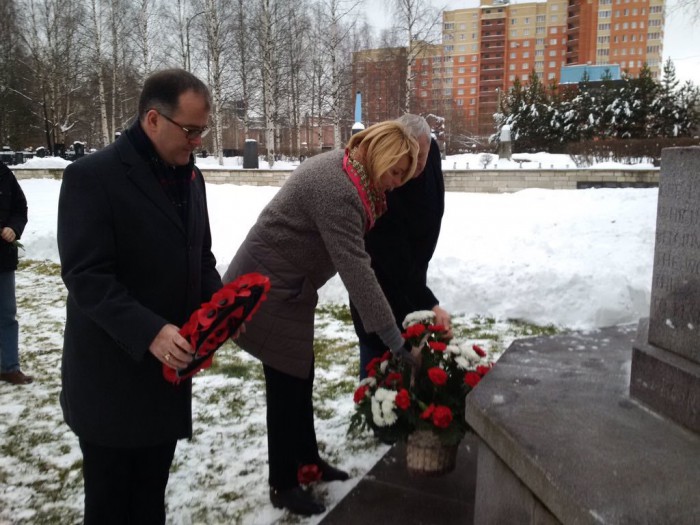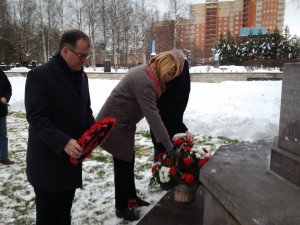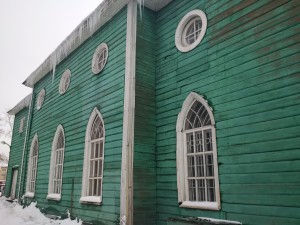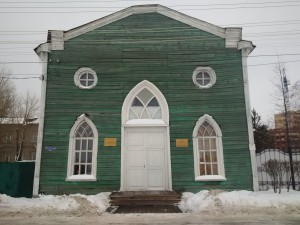8th December 2015
Remembrance in Arkhangelsk, North West Russia

I visited Arkhangelsk in late November as part of our annual visits to the cemeteries in North West Russia where British and Allied servicemen died during World War One, World War Two and the Allied Intervention period of 1918-19. Please see my recent blog about the visit to Murmansk by the Ambassadors of the UK, Australia, Canada and New Zealand.
My last visit to Arkhangelsk was on 31 August for the 74th anniversary of the arrival of the first of the Arctic Convoys. That had been a beautiful sunny day on the banks of the Northern Dvina River. Two months later and winter had arrived. The river was already frozen with a layer of fresh snow on top. But it was good to be back in one of my favourite Russian cities, a city which is full of rich history and culture.
 I laid a wreath at the cemetery in Arkhangelsk. The cemetery is supported by the Commonwealth War Graves Commission and is extremely well maintained. The Acting Head of the City Administration and the Chair of the City Legislative Assembly also joined me.
I laid a wreath at the cemetery in Arkhangelsk. The cemetery is supported by the Commonwealth War Graves Commission and is extremely well maintained. The Acting Head of the City Administration and the Chair of the City Legislative Assembly also joined me.
Visits to Arkhangelsk are always a good opportunity to explore aspects of British history in North West Russia. A member of the Anglican Church community in St Petersburg recently told me the story of the fishing trawler, ‘John High’, which had been requisitioned by the British Admiralty during World War One and converted into a minesweeper. The trawler was sent to the White Sea in Russia as part of a small British flotilla in 1916 to keep the approaches to Arkhangelsk free of mines. Unfortunately, the trawler hit a mine, which had been laid by a German U-boat, and sank with the loss of 14 of its 15-man crew, on 7 August 1916.
 A memorial plaque was placed in the English church, which stood on Northern Dvina Embankment in Arkhangelsk at that time. The church housed the resident Anglican chaplain prior to the Russian Revolution, but was destroyed some years later. Another smaller English church was built by the community in 1853 and was believed to be still standing on Georgiy Sedov Embankment. A relative of one of those who died on the trawler in 1916 was keen to find out what had happened to the memorial plaque. We had made some enquiries via the local administration and museum but no-one had any knowledge of the plaque. I decided to visit the address we had been given for the old church.
A memorial plaque was placed in the English church, which stood on Northern Dvina Embankment in Arkhangelsk at that time. The church housed the resident Anglican chaplain prior to the Russian Revolution, but was destroyed some years later. Another smaller English church was built by the community in 1853 and was believed to be still standing on Georgiy Sedov Embankment. A relative of one of those who died on the trawler in 1916 was keen to find out what had happened to the memorial plaque. We had made some enquiries via the local administration and museum but no-one had any knowledge of the plaque. I decided to visit the address we had been given for the old church.
I was delighted to find the old church still standing on Georgiy Sedov Embankment on the banks of the Northern Dvina River. It stood out immediately as a church with its design and windows. This is an incredible old, wooden building, which has survived war, revolution and the severe northern climate, and is in remarkably good condition. The building has been used as a youth club for many years. The director, who had been working at the club for 35 years, showed me architectural plans from 1999 of a proposed project to restore the building to its original design.
Unfortunately there was no sign of the memorial plaque and I fear we may never know what happened to it after the turbulent days of the Russian Revolution and Allied Intervention. It’s entirely possible that it was removed and taken back to the UK. The plaque read:
‘JOHN HIGH SKIPPER-JAMES H. GRAHAM PETTY OFFICER-DANIEL THOMAS SIGNALMAN-ROBERT NEWSON-WILLIAM MACKENZIE-WILLIAM G. EWING-JOHN SMITH-GEORGE SANDERSON-GODFREY L. CUSHING-WILLIAM PARKS-GEORGE S. COOK-THOMAS H. PERRY-REUBEN W. WOOD-JOHN CAMPBELL-Sacred to the memory of the above, all belonging to His Majesty’s ship “John High”, who fell in the execution of their duty on August 7, 1916, while clearing an Enemy mine-field in the approaches to Archangel. ERECTED BY THE BRITISH RESIDENTS IN ARCHANGEL, 1916’
The crew are commemorated at various naval memorials in the UK and we will continue to remember them and others who served and lost their lives in North West Russia during World War One, the Allied Intervention period and World War Two.


Dear Mr Fidler,
Thank you for sharing this information.
Kind regards,
Consul General Keith Allan
Anyone following these posts my be interested to view our website http://www.northumbriaworldwarone.co.uk
Contains details of the two North Shields crew members including the skipper John High after whom the vessel was named. (see also Robert newsom
Our database includes details of other HMTs lost on Arctic seas duties.
Any information welcome on website contacts page at info@northumbriaworldwarone.co.uk or by email
alan@northumbriaworldwarone.co.uk
Please confirm consent to publish on internet.
Dear Mr Copeland,
We tried to locate the plaque but unfortunately had no luck. Maybe it was taken to the UK during Russian revolution. We will be visiting Arkhangelsk shortly to commemorate the 75th anniversary of the arrival of the first of the Arctic Convoys on 31 August 1941. We will take a moment during this visit to remember those who served and lost their lives on the John High in 1916.
Kind regards,
Keith Allan
My mother, a Henrietta Copeland, was in Archangel in 2013 and was looking for this plaque as she was the granddaughter of John Smith killed on the HMT John High. She didn’t manage to locate the church on her trip though, but she did get the captain of the cruise ship to stop at the approximate location of the sinking and throw some earth into the sea from their croft in The Hebrides. If you do have a copy of the original plaque as mentioned by Tom above she would be delighted to see it.
Dear Mr Graham,
Unfortunately it is not possible to attach a file to a blog comment. Please send the picture to: information.stpetersburg@fco.gov.uk
file:///C:/Users/Graham/Pictures/09-11-2014/My%20Scans/scan0002.jpg
Thank you for your reply to my previous comment.
Scanned photo of original plaque attached for your interest.
Regards, Tom Graham